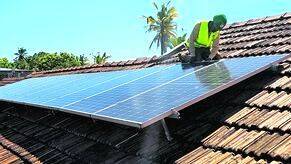

THIRUVANANTHAPURAM: Kerala has exceeded its expectations in rooftop solar power production reaching an impressive 541 MW in November, far surpassing the set target of 500 MW by March 2024. Approximately 1.7 lakh households have already availed connections while an additional three lakh individuals are registered and eagerly waiting for their turn.
For households with electricity bills ranging from Rs 1500 to Rs 2500, a three-kilowatt solar setup suffices. This setup costs around Rs 1.9 to 2 lakh with a substantial 40% subsidy available. After household consumption, the payment to Kerala State Electricity Board (KSEB) stands at a reasonable rate of 2.69 per unit.
Initiated in 2019, Kerala's Rooftop Solar project faced setbacks during the COVID-19 crisis. However, after its relaunch in 2021, there has been an overwhelming demand, resulting in 122.17 MW in 2021 and 127.5 MW in 2022. The upcoming solar city project in Thiruvananthapuram, alongside a 155 MW solar park by the central government is expected to further boost solar power production.
Although subsidized home solar projects have seen significant success, non-subsidized schemes have also contributed generating 352 MW in the state this year alone for systems above 10 KW. Both subsidized and non-subsidized projects are projected to exceed the 1000 MW target this fiscal year.
However, the shortage of materials, from solar panels to three-phase net meters poses a hurdle for further connections. A delayed delivery of net meters resulted in inadequate supply. The net meter allows households to sell excess power to KSEB. To install solar panels approximately 10 square feet of roof space is required per kilowatt of solar energy generation. Interested people can avail solar installations through Kerala State Electricity Board's E-Kiran, Anert and the Centre's MNRE.
For those opting through E-Kiran (ekiran.kseb.in), the payment amount is adjusted after deducting the subsidy. However, in other two schemes, the full payment must be made upfront, and the subsidy amount is later credited to the respective account. Subsidies of 40% are applicable for projects up to three kilowatts. For projects ranging between 3 to 10 kW, the subsidy is reduced to 20%. Projects exceeding 10 kW do not qualify for subsidies.